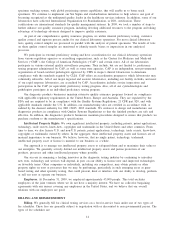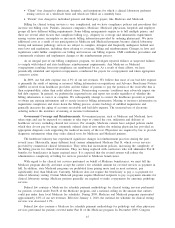Quest Diagnostics 2009 Annual Report Download - page 21
Download and view the complete annual report
Please find page 21 of the 2009 Quest Diagnostics annual report below. You can navigate through the pages in the report by either clicking on the pages listed below, or by using the keyword search tool below to find specific information within the annual report.participation in a health plan network; price; and depth and breadth of test and service offering. Physicians also
purchase and utilize our point-of-care tests.
Health Plans. Health plans typically negotiate directly or indirectly with a number of clinical laboratories,
and represent approximately one-half of our total clinical testing volumes and one-half of our net revenues from
clinical testing. The trend of consolidation among health plans has continued. In certain markets, such as
California, health plans may delegate to independent physician associations (“IPAs”) the ability to negotiate for
clinical testing services on behalf of certain members.
Health plans and IPAs often require that clinical test service providers accept discounted fee structures or
assume all or a portion of the financial risk associated with providing testing services through capitated payment
arrangements and discounted fee-for-service arrangements. Under capitated payment arrangements, we provide
services at a predetermined monthly reimbursement rate for each covered member, generally regardless of the
number or cost of services provided by us. Average reimbursement rates under capitated payment arrangements
are typically lower than our overall average reimbursement rate. Health plans continue to focus product offerings
on point-of-service (“POS”) plans, and consumer driven health plans (“CDHPs”) that offer a greater choice of
healthcare providers. Reimbursement under these programs is typically negotiated on a fee-for-service basis,
which generally results in higher revenue per requisition than under capitation arrangements. In addition, several
health plans have made strategic acquisitions or have developed products to more broadly serve the individual
(non-group) market. We do not expect that the design of these plans will pose a significant barrier to accessing
clinical testing services. Increased number of patients in CDHPs and high deductible plans, such as those offered
in the individual market, generally require greater levels of patient cost-sharing; this could negatively impact
patient collection experience.
Most of our agreements with major health plans are non-exclusive arrangements. Certain health plans,
however, have limited their laboratory network to only a single national laboratory to obtain improved pricing. In
cases where members choose to use a non-contracted provider due to service, quality or convenience, the non-
contracted provider is generally reimbursed at rates considered “reasonable and customary.” Contracted rates are
generally lower than “reasonable and customary” rates.
We also may be a member of a “complementary network.” A complementary network is generally a set of
contractual arrangements that a third party will maintain with various providers that provide discounted fees for
the benefit of its customers. A member of a health plan may choose to access a non-contracted provider that is a
member of a complementary network; if so, the provider will be reimbursed at a rate negotiated by the
complementary network.
We attempt to strengthen our relationships with health plans and increase the volume of testing services by
offering health plans services and programs that leverage our Company’s expertise and resources, including in
such areas as wellness and disease management.
Hospitals. Hospitals generally maintain an on-site laboratory to perform the significant majority of clinical
testing for their patients and refer less frequently needed and highly specialized procedures to outside laboratories,
which typically charge the hospitals on a negotiated fee-for-service basis. Fee schedules for hospital reference
testing typically are negotiated on behalf of hospitals by group purchasing organizations. We provide services to
hospitals throughout the United States, including esoteric testing, in some cases helping manage their laboratories
and serving as the medical directors of the hospital’s histology or clinical laboratory. We believe that we are the
industry’s market leader in servicing hospitals. Hospitals generally continue to look for ways to fully utilize their
existing laboratory capacity: they perform tests their patients need and compete with commercial laboratories for
outreach (non-hospital patients) testing. Continuing to obtain referrals from hospitals depends on our ability to
provide high quality services that are more cost-effective than if the hospitals were to perform the services
themselves. We believe that our combination of full-service, bi-coastal esoteric testing capabilities, medical and
scientific professionals available for consultation, innovative connectivity products, point-of-care testing products,
focus on Six Sigma quality and dedicated sales and service professionals has positioned us to be an attractive
partner for hospital customers.
Most physicians have admitting privileges or other relationships with hospitals as part of their medical
practice. Many hospitals seek to leverage their relationships with community physicians by encouraging the
physicians to send their outreach testing to the hospital’s laboratory. In addition, hospitals that own physician
practices generally require the practices to refer tests to the hospital’s affiliated laboratory. Hospitals can have
greater leverage with health insurers than do commercial clinical laboratories, particularly hospitals that have a
significant market share; hospitals thus are frequently able to negotiate higher reimbursement rates with health
insurance plans than commercial clinical laboratories for comparable clinical testing services.
11
























